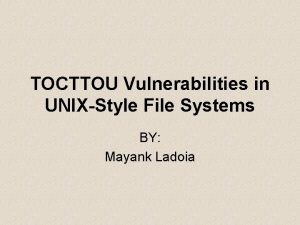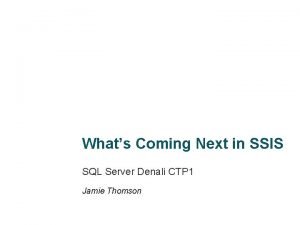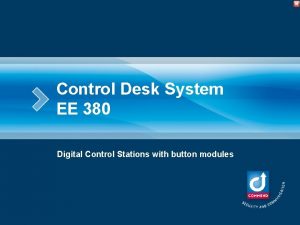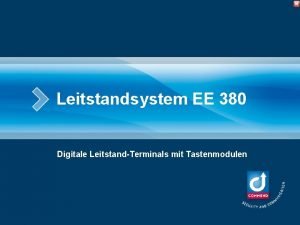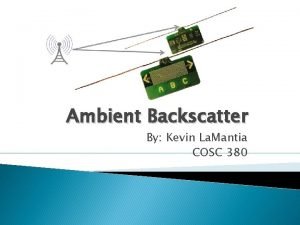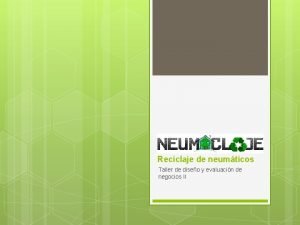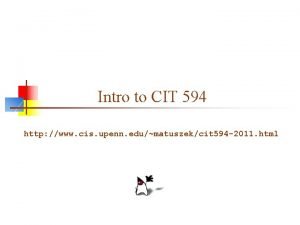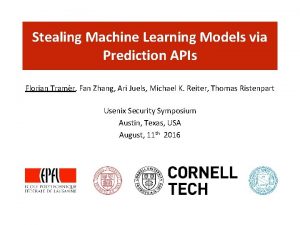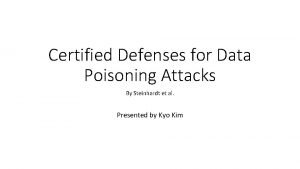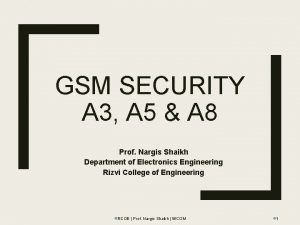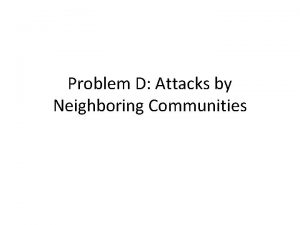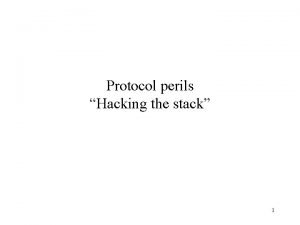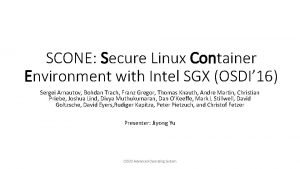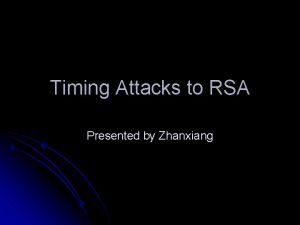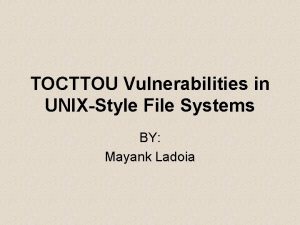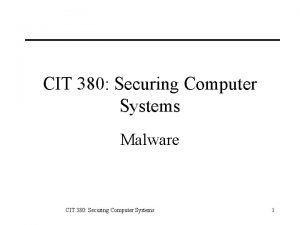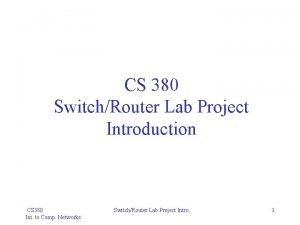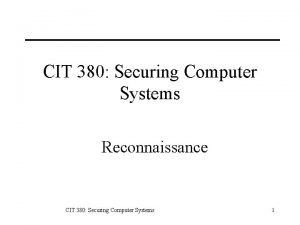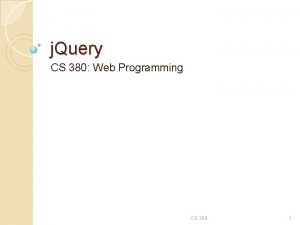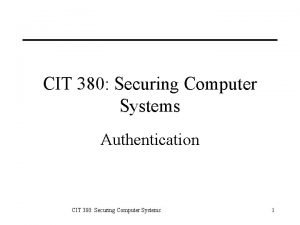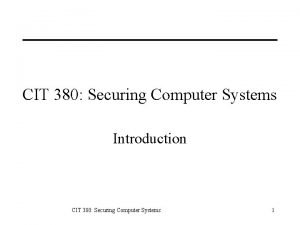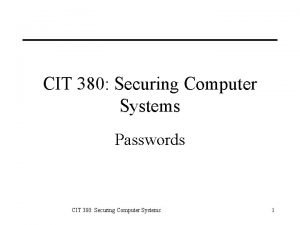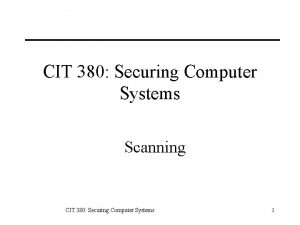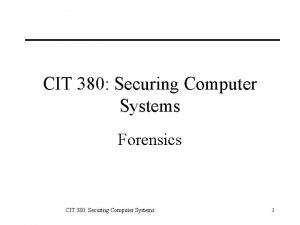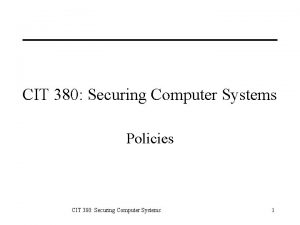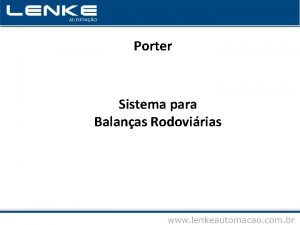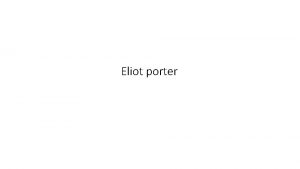CS 380 S TOCTTOU Attacks Don Porter Some





![Broken passwd [Bishop] u Password update program on HP/UX and Sun. OS (circa 1996) Broken passwd [Bishop] u Password update program on HP/UX and Sun. OS (circa 1996)](https://slidetodoc.com/presentation_image_h2/79009280a5d7746d7cb92369b04c599a/image-6.jpg)









![Maze Recap [Borisov et al. ] u. Attacker must track victim’s progress • When Maze Recap [Borisov et al. ] u. Attacker must track victim’s progress • When](https://slidetodoc.com/presentation_image_h2/79009280a5d7746d7cb92369b04c599a/image-16.jpg)











![Pseudo-Transactions [Tsyrklevich and Yee] u. Observation: many sequences of filesystem operations are intended to Pseudo-Transactions [Tsyrklevich and Yee] u. Observation: many sequences of filesystem operations are intended to](https://slidetodoc.com/presentation_image_h2/79009280a5d7746d7cb92369b04c599a/image-28.jpg)











- Slides: 39

CS 380 S TOCTTOU Attacks Don Porter Some slides courtesy Vitaly Shmatikov and Emmett Witchel slide 1

Definitions u. TOCTTOU – Time of Check To Time of Use u. Check – Establish some precondition (invariant), e. g. , access permission u. Use – Operate on the object assuming that the invariant is still valid u. Essentially a race condition u. Most famously in the file system, but can occur in any concurrent system 2

UNIX File System Security u. Access control: user should only be able to access a file if he has the permission to do so u. But what if user is running as setuid-root? • E. g. , a printing program is usually setuid-root in order to access the printer device – Runs “as if” the user had root privileges • But a root user can access any file! • How does the printing program know that the user has the right to read (and print) any given file? u. UNIX has a special access() system call slide 3

TOCTTOU Example – setuid u. Victim checks file, if its good, opens it u. Attacker changes interpretation of file name u. Victim reads secret file Victim Attacker if(access(“foo”)) { symlink(“secret”, “foo”); fd = open(“foo”); read(fd, …); … } time 4

access()/open() Exploit u Goal: trick setuid-root program into opening a normally inaccessible file u Create a symbolic link to a harmless user file • access() will say that file is Ok to read u After access(), but before open() switch symbolic link to point to /etc/shadow • /etc/shadow is a root-readable password file u Attack program must run concurrently with the victim and switch the link at exactly the right time • Interrupt victim between access() and open() • How easy is this in practice? slide 5
![Broken passwd Bishop u Password update program on HPUX and Sun OS circa 1996 Broken passwd [Bishop] u Password update program on HP/UX and Sun. OS (circa 1996)](https://slidetodoc.com/presentation_image_h2/79009280a5d7746d7cb92369b04c599a/image-6.jpg)
Broken passwd [Bishop] u Password update program on HP/UX and Sun. OS (circa 1996) u When invoked with password file as argument… 1. Open password file and read the entry for the invoking user 2. Create and open temporary file called ptmp in the same directory as password file 3. Open password file again, update contents and copy into ptmp 4. Close both password file and ptmp, rename ptmp to be the password file slide 6

TOCTTOU Attack on passwd 1. 2. 3. 4. Create our own subdirectory Fake. Pwd and fake password file pwdfile with blank root password; create symbolic link lnk->Fake. Pwd; run passwd on lnk/pwdfile Open password file and read the entry for the invoking user Change lnk->Real. Pwd to point to real password directory Create and open temporary file called ptmp in the same directory as password file ptmp is created in Real. Pwd Change lnk->Fake. Pwd to point to fake password directory Open password file again, update contents and copy into ptmp contents read from Fake. Pwd/pwdfile and copied to Real. Pwd/ptmp Change lnk->Real. Pwd to point to real password directory Close both password file and ptmp, rename ptmp to password file Now Real. Pwd/pwdfile contains blank root password. Success! slide 7

Directory Removal Exploit Recursive removal of a directory tree (GNU file utilities) Original tree is /tmp/dir 1/dir 2/dir 3 chdir(“/tmp/dir 1”) chdir(“dir 2”) chdir(“dir 3”) unlink(“*”) Suppose attacker executes “mv /tmp/dir 1/dir 2/dir 3 /tmp” chdir(“. . ”) right here rmdir(“dir 3”) unlink(“*”) Fix: verify that inode of chdir(“. . ”) the directory did not This call will delete the change before and rmdir(“dir 2”) entire root directory! after chdir() unlink(“*”) rmdir(“/tmp/dir 1”) slide 8

Temporary File Exploit Suppose attacker creates a symbolic link with the same name as *fn pointing to an existing file // Check if file already exists if (stat(fn, &sb)==0) { fd = open(fn, O_CREAT | O_RDWR, 0); if (fd<0) { err(1, fn); This will overwrite the file to which attacker’s link points } } slide 9

Evading System Call Interposition u. TOCTTOU and race conditions can be used to evade system call interposition by sharing state u. Example: when two Linux threads share file system information, they share their root directories and current working directory • Thread A’s current working directory is /tmp • Thread A calls open(“shadow”); B calls chdir(“/etc”) – Both look harmless; system monitor permits both calls • open(“shadow”) executes with /etc as working directory – A’s call now opens “/etc/shadow” – oops! u. Similar attacks on shared file descriptors, etc. slide 10

Non-Filesystem Race Conditions u. Sockets: create/connect races for local daemons • Open. SSH < 1. 2. 17 u. Symbolic links for Unix sockets • Plash u. Signal handlers • See Zalewski – “Sending signals for Fun and Profit” slide 11

TOCTTOU Vulnerabilities in Red Hat 9 National Vulnerability Database currently has 600 entries for symlink attack Application vi TOCTTOU errors Possible exploit <open, chown> Changing the owner of /etc/passwd to an ordinary user gedit <rename, chown> rpm <open, open> Running arbitrary command emacs <open, chmod> Making /etc/shadow readable by an ordinary user 12 Changing the owner of /etc/passwd to an ordinary user • Jinpeng Wei, Calton Pu. FAST’ 05

How Hard Is It to Win a Race? u. Idea: force victim program to perform an expensive I/O operation • While waiting for I/O to complete, victim will yield CPU to the concurrent attack program, giving it window of opportunity to switch the symlink, working dir, etc. u. How? Make sure that the file being accessed is not in the file system cache • Force victim to traverse very deep directory structures (see Borisov et al. paper for details) slide 13

Maze Attack Replace /tmp/foo -> bar with: /tmp/foo -> 1/a/b/c/d/e/. . . -> 2/a/b/c/d/e/. . . -> k/a/b/c/d/e/. . . -> bar slide 14

Maze Attack, cont. /tmp/foo -> 1/a/b/c/d/e/. . . -> 2/a/b/c/d/e/. . . -> k/a/b/c/d/e/. . . -> bar 1 a/a/b/c/d/e/. . . ->2 a/a/b/c/d/e/. . . ->ka/a/b/c/d/e/. . . -> secret 1) Pollute OS cache with unrelated garbage 2) Pick an arbitrary file in maze, poll atime 3) On update, replace maze slide 15
![Maze Recap Borisov et al u Attacker must track victims progress When Maze Recap [Borisov et al. ] u. Attacker must track victim’s progress • When](https://slidetodoc.com/presentation_image_h2/79009280a5d7746d7cb92369b04c599a/image-16.jpg)
Maze Recap [Borisov et al. ] u. Attacker must track victim’s progress • When to insert symlink? u. After access started: • Monitor access time on a single directory entry u. Before open: • Force disk reads during access slide 16

How hard to prevent TOCTTOU? u. No portable, deterministic solution with current POSIX filesystem API – Dean and Hu 2004 u. Tactics: 1. 2. 3. 4. 5. Static checks for dangerous pairs (compile time) Hacks to setuid programs (least privilege) Kernel detection and compensation (Race. Guard) User-mode dynamic detection Change the interface slide 17

Hardness Amplification (Dean) u. If probability of attacker winning race is p<1, u. Essentially, do the access() n times and make sure they agree before doing the open() u. But what about mazes? • p == 1 slide 18

Take 2 – (Tsafrir ‘ 08) u. Idea: Column-oriented traversal in userspace /a/b/c/. . . k n a b c . . . u. Insight: hard to force scheduling in same directory u. Notes: u User space u Probabilistic slide 19

Cai et al. ‘ 09 u. Idea: Algorithmic complexity attack on filesystem namespace u. Forced victim to be descheduled at end of each syscall without mazes • Even in same directory u. Paper also includes interesting scheduler priority manipulation slide 20

Linux dcache u“foo” hashes to 3 u. Pollute bucket 3 with garbage u. Victim burns timeslice traversing very long hash chain u. OS schedules attacker at end of syscall . . . slide 21

Cai recap u. Disproved intuition about column traversal u. Generalization: probabilistic countermeasures unlikely to every work • Attackers likely to figure out how to single step victim u. Deterministic solutions are the only solutions slide 22

Tsafrir made Deterministic u. Insight 2: Hardness amplification not necessary u. Userspace traversal sufficient with *at() calls: fd 1 = open(“/”); fstatat(fd 1, &statbuf); // do some checks fd 2 = openat(fd 1, “a”); fstatat(fd 2, &statbuf); // more checks fd 3 = openat(fd 2, “b”); . . . slide 23

Caveats u. Slower (many more syscalls) u. Incompatible with exec, O_CREAT • Re-opens door to temp file attacks u. Still requires API changes • openat(), fstatat(), etc. slide 24

How hard to prevent TOCTTOU? u. Tactics: 1. Static checks for dangerous pairs (compile time) - Difficult in practice 2. Hacks to setuid programs (least privilege) - Most common fix for single app 3. Kernel detection and compensation (Race. Guard) 4. User-mode dynamic detection 1. Probabilistic 2. Deterministic – Requires API Changes, Incomplete 5. Change the interface - Most common approach to general problems slide 25

Adapting the API u. In the last 2 years, 13 new system calls have been added to Linux to prevent TOCTTOU • openat, renameat, etc. all take file descriptors u. In the last 3 years, new signal handling • pselect, ppoll change signal mask u. Current proposals for close-on-exec flag to the open system call • Prevents a race between open and fcntl (exploitable in a web browser) u. Cluttered and complicated APIs are the enemy of secure code

Transactions u. Atomic: either the entire transaction succeeds or fails u. Consistent: transactions represent a consistent data structure update u. Isolated: partial results are not visible to the rest of the system. This allows all transactions to be ordered (serialized). u. Durable: they survive computer failures u. Transactions help us reason about concurrency
![PseudoTransactions Tsyrklevich and Yee u Observation many sequences of filesystem operations are intended to Pseudo-Transactions [Tsyrklevich and Yee] u. Observation: many sequences of filesystem operations are intended to](https://slidetodoc.com/presentation_image_h2/79009280a5d7746d7cb92369b04c599a/image-28.jpg)
Pseudo-Transactions [Tsyrklevich and Yee] u. Observation: many sequences of filesystem operations are intended to be atomic • E. g. , nothing should happen betw. access() and open() u. Pseudo-transaction: a sequence of filesystem calls that always behaves as if it were executed in isolation and free from interference • Very well-understood concept in databases u. Idea: OS should recognize when a file transaction starts and prevent interfering system calls slide 28

Tsyrklevich-Yee System u. Look at 2 -call sequences of filesystem calls • Implemented as a kernel module u. Assume that first call starts a pseudo-transaction, second call ends it • Also need to time out misidentified transaction starts u. Treat all filesystem operations originating from the same process as part of same transaction • Assume process doesn’t maliciously interfere with its own filesystem access • Assume fork()’d children run the same process image slide 29

…Also destroyed by Cai et al. ‘ 09 u. Kernel has finite resources to track fs operations u. Idea: pollute the cache with enough garbage to evict first operation • Or manipulate scheduling for false timeout u. Varies by implementation slide 30

System Transactions – SOSP ‘ 09 u. New system calls for transactions • sys_xbegin • sys_xend • sys_xabort u. System calls within an active transaction • atomic: all or nothing • isolated: partial results invisible u. Easy to adopt, just wrap code with transactions u. Deterministic guarantees

TOCTTOU Example Redux u. Attack ordered before or after check and use • System transactions save the day Attacker Victim symlink(“secret”, “foo”); sys_xbegin(); if(access(“foo”)) { fd = open(“foo”); sys_xend(); … symlink(“secret”, ”foo”); time 32

Prototype u. A version of Linux 2. 6. 22 modified to support system transactions • Affectionately called Tx. OS • Runs on commodity hardware • Supports a range of system calls – fs, memory allocation, fork, signals u. Reasonably efficient • Benchmark overheads: 1 -2 x • Some speedups! 33

Questions? uporterde@cs slide 34

Preventing TOCTTOU Races

Typical Setuid-Root File Access // Assume this is running inside some setuid-root program void foo(char *filename) { Check if user has the int fd; permission to read this file if (access(filename, R_OK) != 0) What if the file to which exit(1); filename points changed right here? fd=open(filename, O_RDONLY); … do something with fd … Open file for reading } This is known as a TOCTTOU attack (“Time of Check To Time of Use”) slide 36

Fixing Race Conditions u. Unsafe sequence has been detected. What now? u. Roll back to state before transaction • Requires a heavy-duty file system u. Lock out other processes when a “critical section” of filesystem operations is being executed • How to identify critical sections? • One process gets a lock on entire filesystem (bad idea) u“Delay-lock”: temporarily delay other processes trying to access a locked file • How to calculate the right delay? What if attacker wakes up before victim completes his file operation? slide 37

Default Allow Policy u. Allow every 2 -call sequence except these: ACCESS REMOVE CHDIR REMOVE EXEC REMOVE where REMOVE = UNLINK | RMDIR | RENAME slide 38

Default Deny Policy u. Deny any 2 -call sequence except these: PERMIT(OPEN_RW, PERMIT(OPEN_CREAT, PERMIT(ACCESS, PERMIT(EXEC, PERMIT(CHDIR, PERMIT(RENAME_FROM, PERMIT(RENAME_TO, PERMIT(CHMOD | CHOWN, PERMIT(UTIMES, PERMIT(READLINK, OPEN_RW | ACCESS | UTIMES | CHDIR | EXEC | UNLINK | READLINK | CHMOD | CHOWN | RENAME) OPEN_RW | ACCESS | UTIMES | CHDIR | EXEC | RENAME_FROM) OPEN_RW | ACCESS | UTIMES | CHDIR | EXEC) OPEN_READ | CHDIR | ACCESS | READLINK) OPEN_RW | ACCESS | UNLINK | RENAME_FROM) OPEN_RW | ACCESS | CHMOD | CHOWN) READLINK) slide 39
 Tocttou
Tocttou Tocttou attack example
Tocttou attack example Nyogel 774vh
Nyogel 774vh Ssis 380
Ssis 380 Planningme
Planningme Dönem ayirici hesaplar 180 181 280 281 380 381
Dönem ayirici hesaplar 180 181 280 281 380 381 Zodiac cadet 270 alu
Zodiac cadet 270 alu Dönem ayirici hesaplar 180 181 280 281 380 381
Dönem ayirici hesaplar 180 181 280 281 380 381 Ee 380
Ee 380 Town b is 380 km due south of town a
Town b is 380 km due south of town a 380 lexington ave
380 lexington ave 380 gelir tahakkukları
380 gelir tahakkukları Ee 380
Ee 380 690-380
690-380 Kevin 380
Kevin 380 Romsat.ua
Romsat.ua 507-802-380
507-802-380 Upenn cis
Upenn cis 450 en yakın onluğa yuvarlama
450 en yakın onluğa yuvarlama To take something that doesn't belong to you
To take something that doesn't belong to you Contact force
Contact force Sometimes you win some
Sometimes you win some Fire and ice diamante poem
Fire and ice diamante poem Sometimes you win some
Sometimes you win some Some say the world will end in fire some say in ice
Some say the world will end in fire some say in ice Ice cream count or noncount
Ice cream count or noncount Some trust in chariots and some in horses song
Some trust in chariots and some in horses song Stealing machine learning models via prediction apis
Stealing machine learning models via prediction apis Types of phishing attacks
Types of phishing attacks Certified defenses for data poisoning attacks
Certified defenses for data poisoning attacks Zero-day attacks
Zero-day attacks Malicious attacks threats and vulnerabilities
Malicious attacks threats and vulnerabilities Cryptographic attacks
Cryptographic attacks Attacks by neighboring communities
Attacks by neighboring communities Hijacking attacks
Hijacking attacks Untargeted cyber attacks
Untargeted cyber attacks Hijacking attacks
Hijacking attacks Docker computer science
Docker computer science Scone: secure linux containers with intel sgx
Scone: secure linux containers with intel sgx Rsa attacks
Rsa attacks
